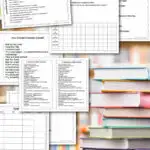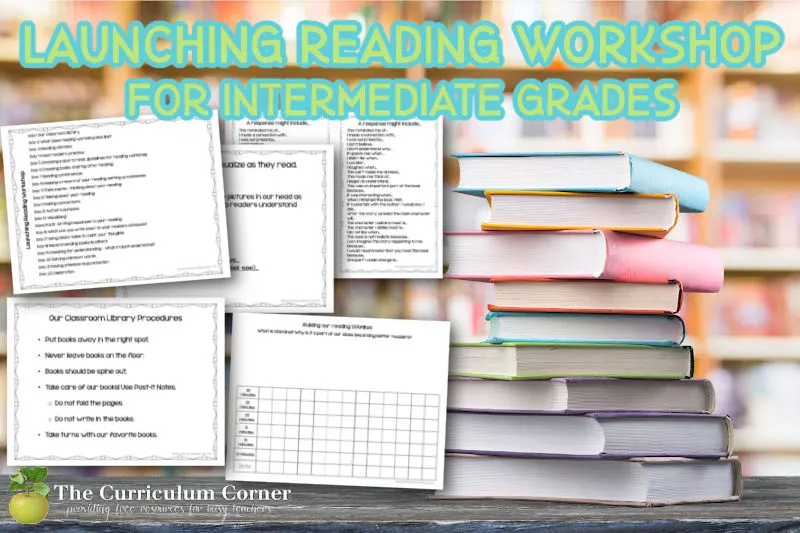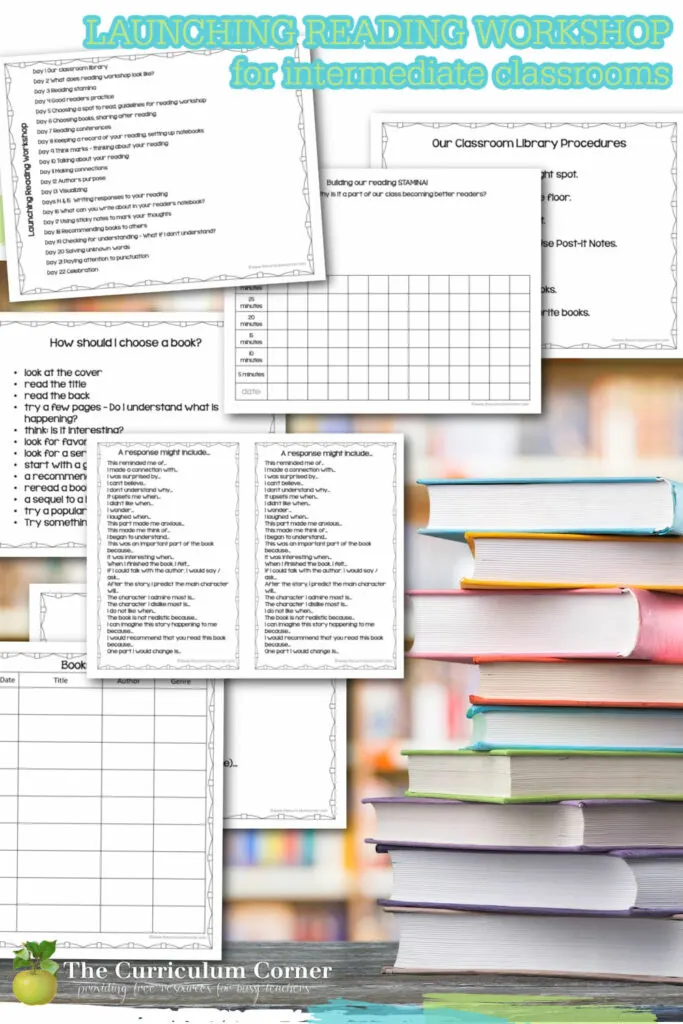Use this unit when you are launching your reader’s workshop in 4th, 5th or 6th grade.
This launching your reader’s workshop unit of study has been updated with new lessons and printables.
You will find everything you need to set up your intermediate readers for a successful reading workshop!
This is another free resource for teachers from The Curriculum Corner.
The First 20 Days – Launching reader’s workshop
A traditional reading workshop in the primary classroom often begins with The First 20 Days as outlined by Fountas and Pinnell. The key to these days is setting procedures for the classroom and your workshop. You want students to understand the purpose of a workshop and what they should be doing.
As I am getting to know my sixth grade readers, I am finding that I have a good portion of students not yet familiar with a true reading workshop. Because of this, I will be using each of the lessons I am sharing below. If your students have had a true workshop for many years, you might be able to condense or skip lessons that your students understand.
However, when it comes to procedures, there can be benefits to reviewing many of these lessons so that students understand your expectations.
In order for a workshop to work well, students need to be able to work independently while following your expectations.
Because the purpose of these lessons is to set procedures, many of these will not meet standards for your grade level.
Your schedule when launching your reading workshop
Before you begin, think about the time you have and what your schedule will look like.
Some classrooms will have students with them all day and other classrooms will have an hour or less for teaching reading and writing. Start by deciding what you must include each day and then add in the other pieces.
Bell ringer: If your class will be coming to you just for reading, you might start with a question on the board for a quick response. Some days it might be at ask like find a nonfiction book for reading today. Or, you might have students to share an adjective on the white board.
Mini-lesson: Keep this short! Maybe 10-15 minutes at the most. This will be your direct instruction.
Independent reading: This will be 20 – 30 minutes. During this time you will be conferencing and running small groups.
Wrap-up: This is your share time. After independent reading, students will gather back together. You will have them share either a point someone made during a conference you want others to know or what they completed during independent reading.
Day 1: Our Classroom Library
Spend the first day to introduce your students to your library. Talk about how our library is set up. This is a good time to introduce your library procedures. Do you have a check out system?
You will find a book checkout page and a classroom library procedures.
Day 2: What does reading workshop look like?
Ask your students to share what they will see during reading workshop. Create an anchor chart as you go. I included all answers and then went back and crossed off answers that will not fit our workshop. For example, my students said I would be grading papers or working on my computer. As we wrapped up, we talked about my job and added that to our chart. I included that I would be conferencing or running small groups.
You will find an anchor chart that can be used for this and lesson 5.
Day 3: Reading stamina
On this day we talked about the meaning of stamina and how this relates to reading. I found that my students are pretty good at reading independently so our first day we set of goal of 15 minutes and it was easily met. We are slowly increasing it to 30 minutes as time allows each day.
You will find a graph you can use for tracking reading stamina. My two blocks of students like competing but so far they have had equal time each day.
Day 4: Good readers practice
You can begin by talking about how we become better at the things we love by practicing – this concept is easy to apply to sports, dance and many other activities children participate in. This lesson used to suggest using an old rehearsal video of Miley Cyrus and Taylor Swift. The song practiced was popular the time. However, the video quality is not good and I’m not sure students are still familiar with the song.
In my class, I used the song “This is Me” from The Greatest Showman. It was perfect for many reasons. First, we are working on affirmations and were getting reading to write I am from… poems. I began by providing my students with the lyrics and working on a shared reading. This got in my shared reading and allowed us to talk about poetry (which also fit our writing for the day.) After we practiced reading, I shared the rehearsal video for the movie: Video. If you search, you can also find the video from the movie that has the words on the screen. This made it fun for the students to sing along to as we watched a second time.
Day 5: Guidelines for reading workshop & choosing a spot to read
This is a good time to go over your expectations. Use the anchor chart from lesson 2 for this if needed. Or, create your own with your class.
Along with the guidelines, you might also talk about choosing a spot to read. I always let my students move around and find a comfy spot to read. They are going to be more engaged with their reading if they are comfortable. While last week they were given free choice, this coming week I am going to add a couple of guidelines. I never mind when students sit under tables or other spots but I’ve had a few that are way too chatty (and not about their reading.) Monday I’m going to have my students start sitting out of arm reach.
Day 6: Choosing books and sharing after reading
By this age, many students have ideas of how they typically choose books. However, it doesn’t hurt to do a review for those students who might not always make choices that are good for them. At the end of this day, you can have students gather back together and share how they chose their book. This will be a good start to your share time at the end of independent reading.
You will find an anchor chart titled How should I choose a book?
Day 7: Conferencing
One job of the teacher during independent reading is conferencing with students. Use this time as a check in. At first, you might simply be getting to know your students and asking them to tell you about what they like to read. I made these forms to use to record our conferences: Conference Forms.
If you aren’t sure what topics to cover during a conference, I have this: Conference Guide. This was written when I was teaching second grade so I feel like adjustments will need to be made for intermediate grades. However, if you are new to conferencing, it could still be helpful.
My goal is to always meet with students at least once a week. Struggling readers benefit from more than one conference a week. On top of asking students what they are reading and what they are doing well, you should also share a teaching point. This is what you want students to work on.
While you are conferencing, you will want to make sure students know not to interrupt. This is easier with older students but there is a parking lot poster that can be used in the download as needed. You can teach students that they will put their question on a Post-it and stick it to the parking lot. In between conferences, you can check and see if there is anything you need to address before moving on.
Day 8: Keeping a record of your reading, setting up notebooks
On this day, you can have students begin their reading notebooks. I will be using a composition notebook. In the beginning, I will have them leave a few pages blank so we can add a table of contents. Next, we will divide notebooks into three sections and use Post-it tabs to mark each section.
I am planning on using the following sections:
- Organizers
- Reading record
- Letters
I’m not sure about the title of the first section yet so that might change.
I might have the reading record section be a little smaller than the others. Students can simply write down the titles and genres of the books they are reading. Or, you can have them glue the Books I’ve Read chart into their notebooks.
Day 9: Think marks
On this day you will be talking about the fact that good readers think as they read. I am going to use these materials on think marks: Using Think Marks. Everything you need for think marks can be found within the blog post linked.
Day 10: Talking about your reading
This is a good lesson to follow the think marks. On this day, you will be allowing students to model how they can talk about their reading. I would have students use a Post-it note during independent reading on this day. Tell them that they are to use the think marks and mark what they are thinking. At the end of independent reading, you will have your students share with a partner.
Day 11: Making connections
You can use this post to help you touch on making connections: Making Connections. I will choose a graphic organizer for my students to complete as they are reading. We will use our share time to talk about the connections students made. The idea of making connections will be revisited in future units to emphasize how it can be easier to understand what we read if we have connections to it.
Day 12: Author’s purpose
Today you will focus on helping readers think about why an author wrote what they are reading. You can use this resource: Author’s Purpose. Part of the download available here includes a PowerPoint where children can practice identifying the author’s purpose. There are also other items available.
Today have students write down the author’s purpose on a Post-it note while they read. Share after independent reading.
Day 13: Visualizing
Visualizing happens when readers make pictures in their head as they read. Sometimes we tell readers this is like making a movie of the book in our head.
During your mini-lesson, talk about what visualizing is. Read a passage from a favorite book (just a paragraph or two!) As you read, ask students to close their eyes. When you are done, ask for volunteers to share what they saw. You can repeat this a few times for practice. I will be using a page or two from read-alouds we have done in the classroom.
Today, each student should choose a spot in their reading. They will draw a picture on a Post-it note to show what they saw. Students can share at the end of independent reading.
Days 14 & 15 Writing responses to your reading
This plan might turn into three days! I used to have my fifth graders write me a letter about their reading once a week. The hardest part about this assignment is that I always made sure to write back. It was time consuming but there were so many positives that it was worth it!
You can read more here: Writing Reading Response Letters
Day 16 What can you write about in your reader’s notebook?
On this day, begin by having students share their ideas. You can create an anchor chart as you go. You will find a half page students can glue into their reading notebooks with a large list of ideas. You can then have students write in other ideas they have.
Their job during reading today can be to choose one and make a note on a Post-it note.
Day 17: Using sticky notes to mark your thoughts
We have done a lot of talking about the types of responses we might make as we read. Today you will ask that students use three Post-it notes during independent reading. Their job is to record three thoughts they have as they read. During share time, have them share one of their responses with a partner.
Day 18: Recommending books to others
Sometimes a friend recommending a book is a great way to help reluctant readers to try something new! Today students will learn about a way to share a book with a classmate.
In the download you will find two pages of bookmarks. Share these with students. On the bookmark, they will record a sentence about their recommendation. These bookmarks can be good but you can also simply have students record their recommendation on a Post-it note. During share time, their job will be to share their book with a student they think will like it.
Day 19: Checking for understanding
Part of becoming a better reader is making sure you understand what you are reading. Some students might read without checking in on their understanding. Your job is to help them remember to stop and think. During previous lessons we have taught students ways to record their thinking. Today you can emphasize that an important piece of thinking while reading is stopping and asking yourself: Do I understand what I just read? We want this process to become habit so that when readers are stuck, they help themselves.
Obviously since you are just doing a quick mini-lesson today, this will not cover all of the ways students can check for understanding. Today you can ask students to stop at the end of each page and think about what they read. For one page, have them write a sentence or two on a Post-it to share.
Day 20: Solving Unknown Words
Use the book Mufaro’s Beautiful Daughter by John Steptoe.
This is a book that has a variety of words which might be new to students. As you read the story aloud, encourage students to use context clues to determine the meaning of unknown words. Once students have made their predictions, discuss how they might work to confirm the definitions.
Help students create a list that includes resources such as asking a classmate, using a dictionary and looking on the computer. We like to create a chart that includes a column for the word, a column for the prediction of the word and then a column where students can record the dictionary definition.
If you are looking for a graphic organizer to use, you will find many here: Info Text Vocabulary Organizers.
Day 21: Paying attention to punctuation
This is a fun lesson that can definitely be eliminated. It is great for younger kids but older ones enjoy it as well even though it is simple.
Before this lesson, cover up the punctuation in the book Yo! Yes? by Chris Raschka with Post-It notes.
Gather the class and attempt to read this book without the punctuation. It will be difficult and not make much sense. Discuss how even the smallest amount of punctuation can contribute so much to what an author is meaning to express in a text. Remove the Post-It notes and read the book again, putting extra emphasis on the punctuation and meaning as you read.
This discussion is a way to help students see how it is important to pay attention to punctuation as they read. Punctuation can change the meaning of a story.
Day 22: Celebration
By now you should have a working reading workshop! Celebrate your accomplishment by bringing in a snack to share during independent reading.
During your mini-lesson time you might have students share what they think they have done well as a class and what they can still work on.
You can download the materials for this launching reader’s workshop unit by clicking on the apples below:

Looking for a way to manage your reading data? We have created a complete management binder… Reading Management Binder
**To help with the development of our Launching unit, we used the following resources:
Guiding Readers and Writers: Grades 3-6 by Irene C. Fountas and Gay Su Pinell
Teaching Reading in Middle School by Laura Robb
**Clip Art by Pink Pueblo




Ms. LaShugn Lloyd
Tuesday 28th of January 2020
I love, love, love your site. I have shared it with my colleagues. Thank you so much for making quality products for FREE for busy teachers like me!
Welcome to the The Curriculum Corner 456 - The Curriculum Corner 4-5-6
Thursday 6th of October 2016
[…] Launching Your Reading Workshop Unit of Study Created in cooperation with VariQuest, this unit has a rock and roll theme. […]
Nat
Tuesday 30th of December 2014
Absolutely fantastic post, and very helpful! Would love more/similar ideas! Thank you so much! :)
Staci
Thursday 17th of July 2014
I never leave comments, but I absolutely had to here. I've been searching for a reader's workshop explanation for quite a while. Your post is amazing and I finally feel like I have a clear path to implement reader's workshop. Thank you SO much for sharing all of your anchor charts and data sheets! I'm one very happy teacher :)
Mrs.Roberts
Tuesday 13th of August 2013
Wow! You have great stuff on here! Thank you! Is there a way to get the parking lot sign to upload? There were a few things that wouldn't upload. Thanks again!!!
admin
Friday 30th of August 2013
Thanks Lauren! These should be fixed now!